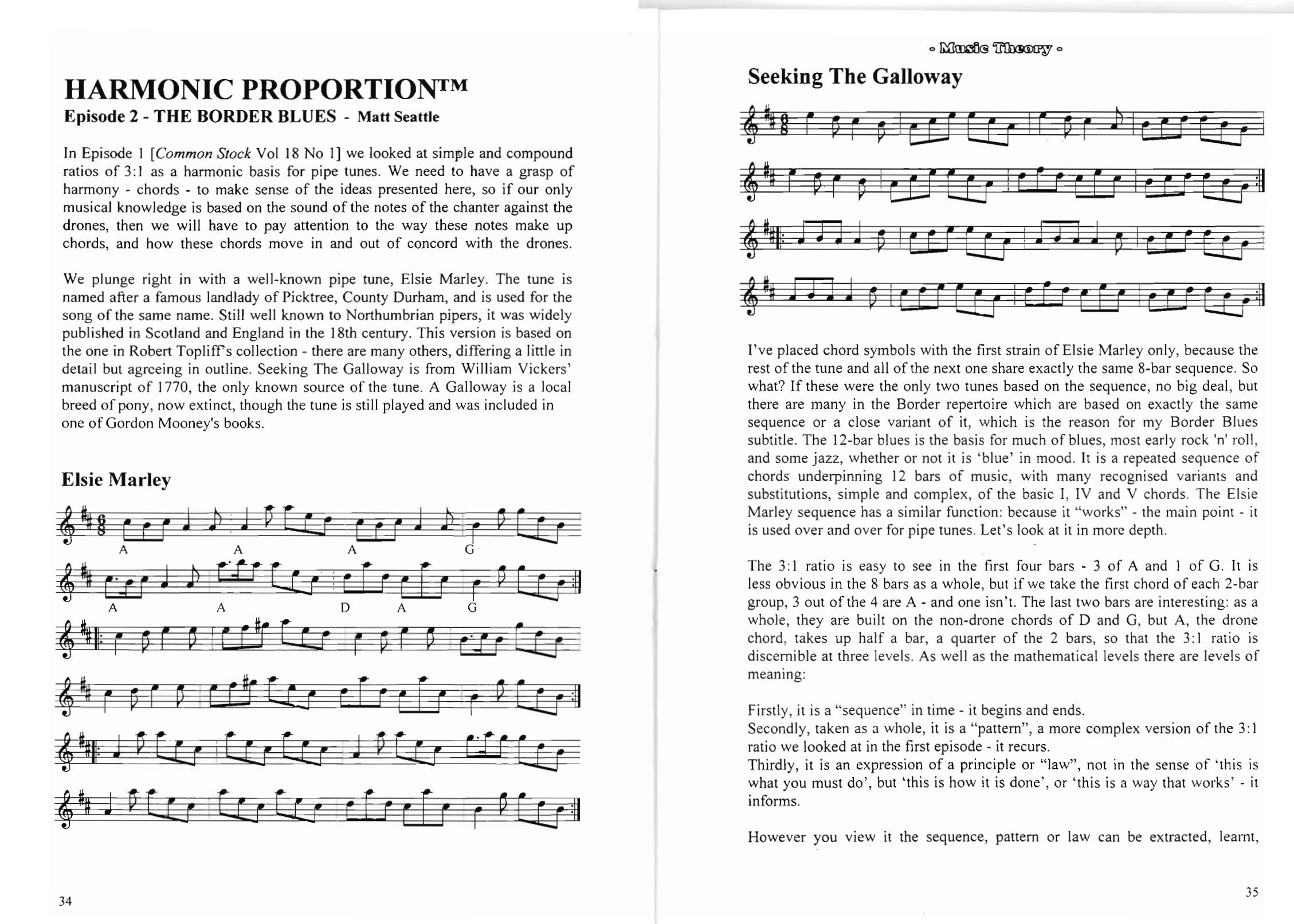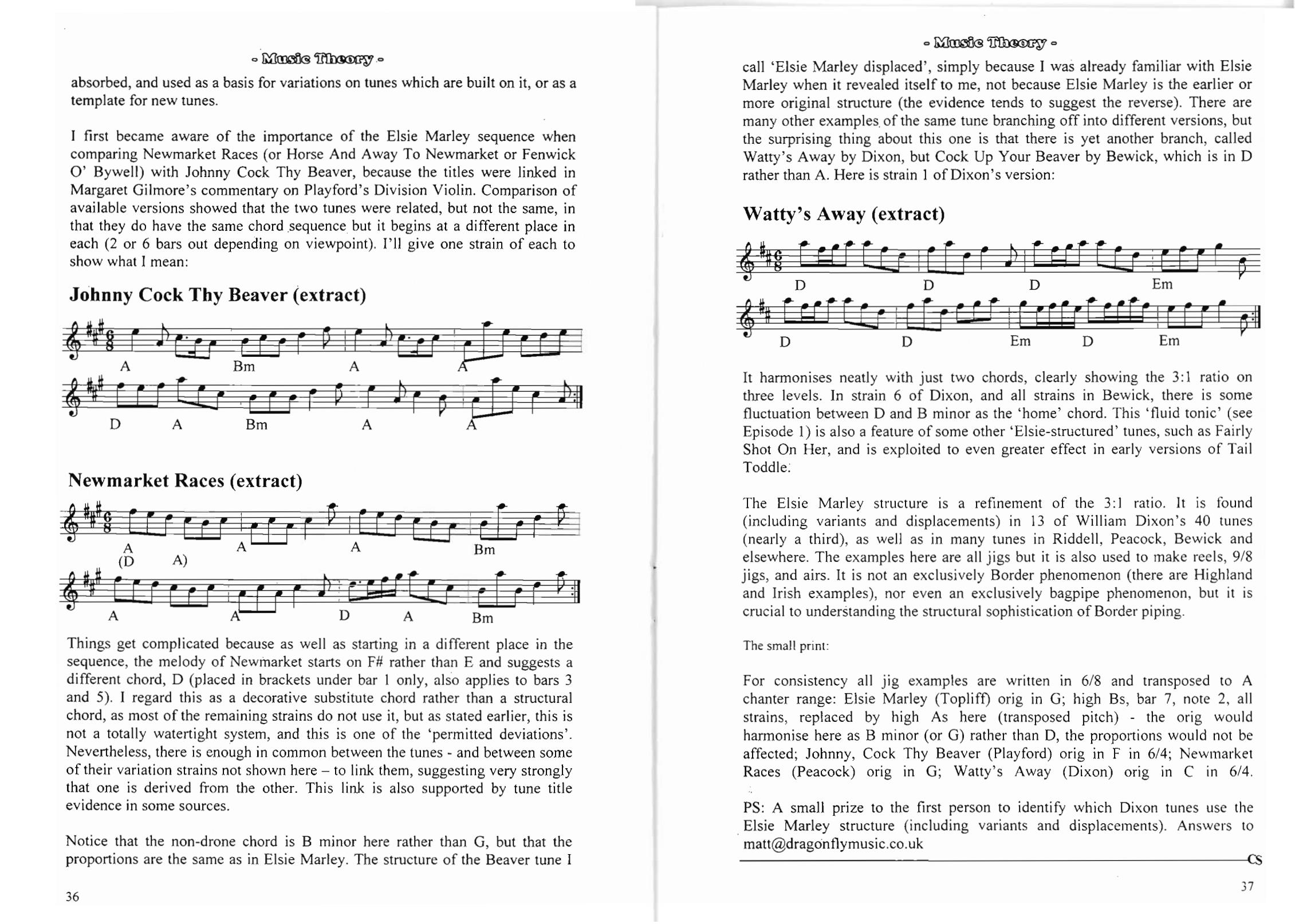Harmonic Proportion 2


Episode 2 - THE BORDER BLUES - Matt Seattle
In Episode 1 [Common Stock Vol 18 No 1] we looked at simple and compound ratios of 3:1 as a harmonic basis for pipe tunes. We need to have a grasp of harmony - chords - to make sense of the ideas presented here, so if our only musical knowledge is based on the sound of the notes of the chanter against the drones, then we will have to pay attention to the way these notes make up chords, and how these chords move in and out of concord with the drones.
We plunge right in with a well-known pipe tune, Elsie Marley. The tune is named after a fa- mous landlady of Picktree, County Durham, and is used for the song of the same name. Still well known to Northumbrian pipers, it was widely published in Scotland and England in the 18th century. This version is based on the one in Robert Topliff’s collection - there are many others, differing a little in detail but agreeing in outline. Seeking The Galloway is from Wil- liam Vickers’ manuscript of 1770, the only known source of the tune. A Galloway is a local breed of pony, now extinct, though the tune is still played and was included in one of Gordon Mooney’s books.
I’ve placed chord symbols with the first strain of Elsie Marley only, because the rest of the tune and all of the next one share exactly the same 8-bar sequence. So what? If these were the only two tunes based on the sequence, no big deal, but there are many in the Border repertoire which are based on exactly the same sequence or a close variant of it, which is the reason for my Border Blues subtitle. The 12-bar blues is the basis for much of blues, most early rock ‘n’ roll, and some jazz, whether or not it is ‘blue’ in mood. It is a repeated sequence of chords underpinning 12 bars of music, with many recognised variants and sub- stitutions, simple and complex, of the basic I, IV and V chords. The Elsie Marley sequence has a similar function: because it “works” - the main point - it is used over and over for pipe tunes. Let’s look at it in more depth.
The 3:1 ratio is easy to see in the first four bars - 3 of A and 1 of G. It is less obvious in the 8 bars as a whole, but if we take the first chord of each 2-bar group, 3 out of the 4 are A - and one isn’t. The last two bars are interesting: as a whole, they are built on the non-drone chords of D and G, but A, the drone chord, takes up half a bar, a quarter of the 2 bars, so that the 3:1 ratio is discernible at three levels. As well as the mathematical levels there are levels of meaning:
Firstly, it is a “sequence” in time - it begins and ends.
Secondly, taken as a whole, it is a “pattern”, a more complex version of the 3:1 ratio we looked at in the first episode - it recurs.
Thirdly, it is an expression of a principle or “law”, not in the sense of ‘this is what you must do’, but ‘this is how it is done’, or ‘this is a way that works’ - it informs.
However you view it the sequence, pattern or law can be extracted, learnt absorbed, and used as a basis for variations on tunes which are built on it, or as a template for new tunes.
I first became aware of the importance of the Elsie Marley sequence when comparing Newmarket Races (or Horse And Away To Newmarket or Fenwick O’ Bywell) with Johnny Cock Thy Beaver, because the titles were linked in Margaret Gilmore’s commentary on Playford’s Division Violin. Comparison of available versions showed that the two tunes were related, but not the same, in that they do have the same chord sequence but it begins at a different place in each (2 or 6 bars out depending on viewpoint). I’ll give one strain of each to show what I mean:
Things get complicated because as well as starting in a different place in the sequence, the melody of Newmarket starts on F# rather than E and suggests a different chord, D (placed in brackets under bar 1 only, also applies to bars 3 and 5). I regard this as a decorative substitute chord rather than a structural chord, as most of the remaining strains do not use it, but as stated earlier, this is not a totally watertight system, and this is one of the ‘permitted deviations’. Nevertheless, there is enough in common between the tunes - and between some of their variation strains not shown here - to link them, suggesting very strongly that one is derived from the other. This link is also supported by tune title evidence in some sources.
Notice that the non-drone chord is B minor here rather than G, but that the proportions are the same as in Elsie Marley. The structure of the Beaver tune I call ‘Elsie Marley dis- placed’, simply because I was already familiar with Elsie Marley when it revealed itself to me, not because Elsie Marley is the earlier or more original structure (the evidence tends to suggest the reverse). There are many other examples, of the same tune branching off into
different versions, but the surprising thing about this one is that there is yet another branch, called Watty’s Away by Dixon, but Cock Up Your Beaver by Bewick, which is in D rather than A.
Here is strain 1 of Dixon’s version:
It harmonises neatly with just two chords, clearly showing the 3:1 ratio on three levels. In strain 6 of Dixon, and all strains in Bewick, there is some fluctuation between D and B minor as the ‘home’ chord. This ‘fluid tonic’ (see Episode 1) is also a feature of some other ‘Elsie-structured’ tunes, such as Fairly Shot Of Her, and is exploited to even greater effect in early versions of Tail Toddle:
The Elsie Marley structure is a refinement of the 3:1 ratio. It is found (including variants and displacements) in 13 of William Dixon’s 40 tunes (nearly a third), as well as in many tunes in Riddell, Peacock, Bewick and elsewhere. The examples here are all jigs but it is also used to make reels, 9/8 jigs, and airs. It is not an exclusively Border phenomenon (there are Highland and Irish examples), nor even an exclusively bagpipe phenomenon, but it is crucial to understanding the structural sophistication of Border piping.
The small print:
For consistency all jig examples are written in 6/8 and transposed to A chanter range: Elsie Marley (Topliff) orig in G; high Bs, bar 7, note 2, all strains, replaced by high As here (transposed pitch) - the orig would harmonise here as B minor (or G) rather than D, the proportions would not be affected; Johnny, Cock Thy Beaver (Playford) orig in F in 6/4; Newmarket Races (Peacock) orig in G; Watty’s Away (Dixon) orig in C in 6/4.
PS: A small prize to the first person to identify which Dixon tunes use the Elsie Marley
structure (including variants and displacements). Answers to This email address is being protected from spambots. You need JavaScript enabled to view it.
